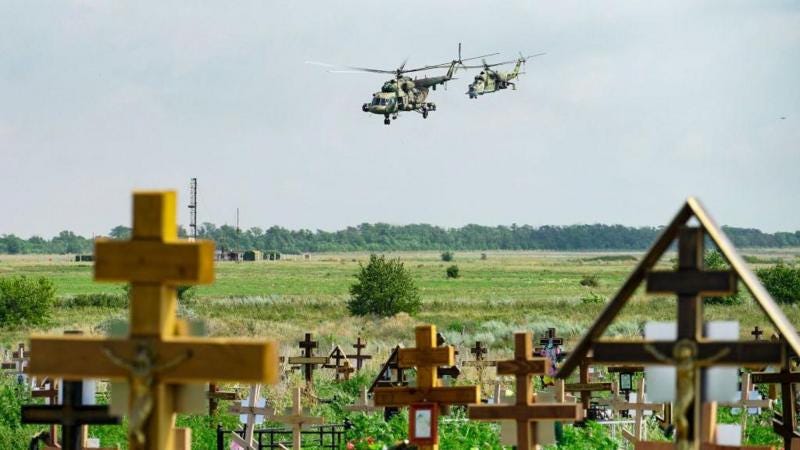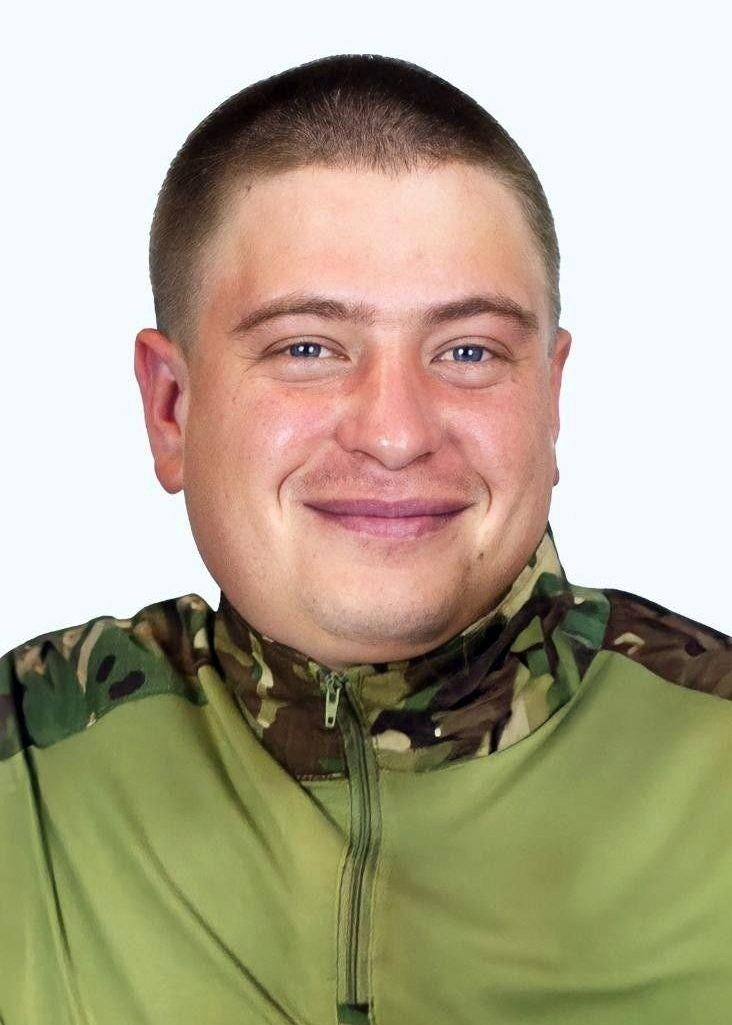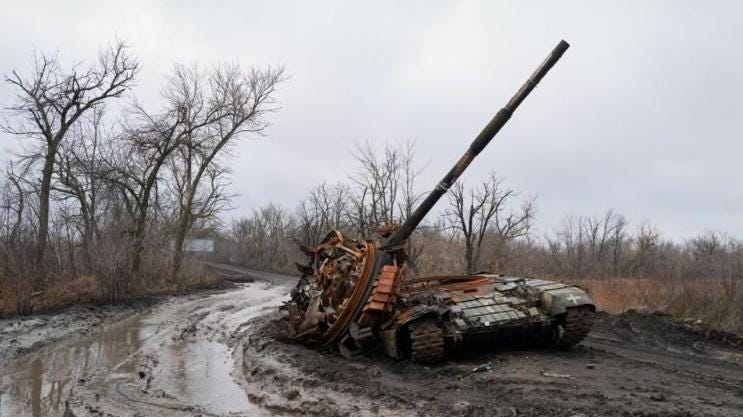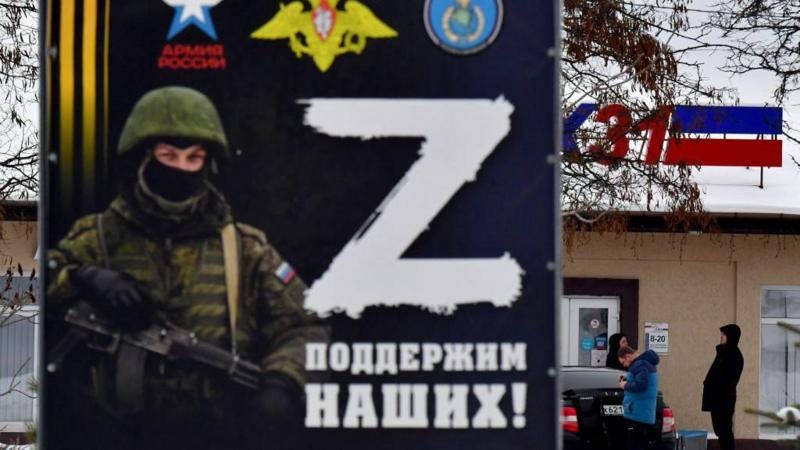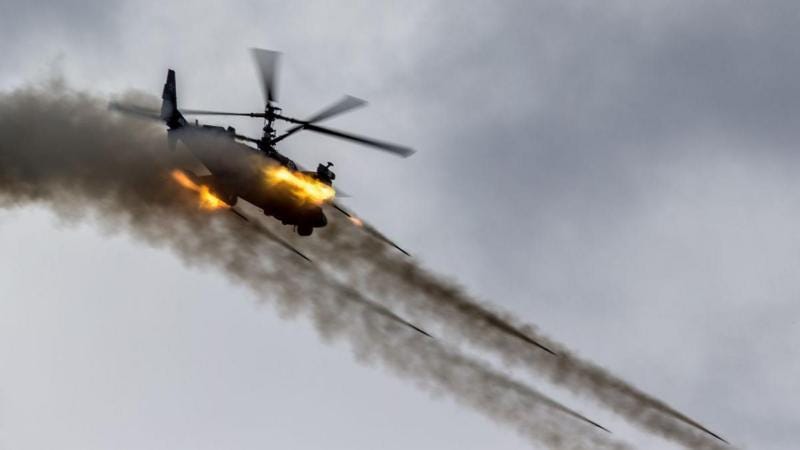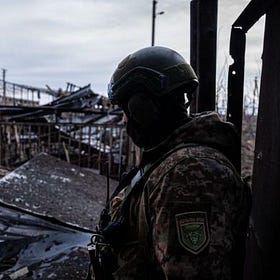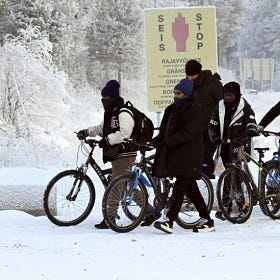Counting Russia's dead in Ukraine. More than 45,000 confirmed killed
What we can say about Russia's military losses in Ukraine after two years of war. The total number of dead may be close to 115,000.
By Olga Ivshina.
Working with open source information, the BBC, together with the "Mediazona" outlet and a team of volunteers, has managed to establish the names of 45,123 Russian military personnel killed in the war in Ukraine since February 2022. Of these, at least 6614 died between October 2023 to February 2024 – in other words, while Russian units were advancing towards Avdiivka and neighbouring areas of Donetsk Oblast.
An analysis of published obituaries suggests that during the storming of Avidiivka the heaviest toll fell on civilians who ended up in the army: prisoners of Russian penal colonies, volunteers, and conscripts.
30-year-old Denis Kuznetsov was conscripted into the war from Irkutsk in Siberia. On December 29, 2023, he was wounded by shrapnel. He was sent back to the front line near Avdiivka less than a month later. On January 29, Kuznetsov was wounded by a shell dropped from a drone. His fellow soldiers found him dead on January 31.
The total Russian losses we have been able to confirm for 2023 came to 27,906, which is 57% more than the confirmed number for the first year of the full-scale invasion of Ukraine (16,044 individuals). These are merely the figures we can establish from open sources. According to our estimates, the true number of Russian casualties (excluding military personnel from the Luhansk and Donetsk ‘People’s Republics’) may be twice as high.
We reached this conclusion by systematically studying burials in cemeteries at 70 locations throughout Russia.
Russian losses in detail
Confirmed Russian weekly losses began to significantly increase from October 2023. In August and September, an average of 360 military personnel were being confirmed killed each week. But as from October 9, the confirmed weekly losses increased to 550-600 individuals. The rise in casualties coincided with the start of the operation to take Avdiivka and other nearby settlements by storm – fighting for the city has been ongoing since February 2022.
Between October 2023 and February 20, 2024, we confirmed the death of 6614 Russian military personnel. Some obituaries did not specify the place of death, so it cannot be stated with certainty that all these individuals were killed during the advance on Avdiivka. That said, the figures for casualties around Avdiivka are definitely greater than those we have established for other locations on the frontline. US intelligence reports suggest that Russian ‘irrecoverable’ losses – killed or seriously wounded – amount to roughly 13,000 on the Avdiivka-Novopavlivka line.
Overall, the scale of Russian losses last autumn is second only to those experienced during the storming of Vuhledar and Bahmut in the winter and spring, when the death rate was twice the average for the previous year, 2022.
Formidable defensive fortifications were built by Ukraine in Avdiivka as early as 2014, just after pro-Russian separatists, backed by Russian forces, captured neighbouring Donetsk. As a consequence, the Russian army knew they could not overcome these defensive lines in a single bound, and the assault turned into the obliteration of the town by airstrikes and attempts to storm it with infantry units. Moscow took significant losses, but achieved its goal, capturing the last line of defence from the Ukrainians earlier this month.
General trends
The main trend of the second year of Russia's full-scale invasion of Ukraine is a sharp rise in casualties among those conscripted to the front from civilian life. At this point, two-thirds of all the deaths we have confirmed were people who were not associated with the army before the invasion – volunteers, conscripts, prisoners, and members of Russia’s so-called private military companies.
And if in the first year of the war men over the age 40 often volunteered for the front, now more and more young people are signing up. In 2023, at least nine men born in 2005 and 55 born in 2004 died in the war. They were barely 18 years old when they enlisted.
"Daniel signed a contract the day after his 18th birthday. It’s hard to say why now. He wanted to enrol in a military-medical academy next year. He was basically a patriot and wanted to put himself to the test,” Daniel Chistyakov’s relatives told us. “We couldn’t talk him out of it."
This summer, Daniel graduated from school in Smolensk. By autumn, he was already on the front line as part of an assault battalion. "He began his service on August 26 and died on October 16," his relatives said.
There was no mention of his death on the social media page of Daniel’s school. But there is an advertisement for military recruitment contracts. Last spring, Russia’s parliament, the State Duma, approved legal amendments permitting 18-year-old high school graduates to sign contracts with the Ministry of Defence. In just two years of war, at least 1240 soldiers under the age of 20 have perished at the front.
But if we look at the average statistics, the typical Russian fighter killed in Ukraine in 2023 is now a 34-year-old prisoner who went to the front line straight from jail. While in 2022 the majority of convicts were recruited by the Wagner mercenary group, that work has been handled by Russia’s defence ministry alone since February 2023. The military command is trying to protect those paratroopers and special forces who survived the early months of the war, using them to hold positions and execute sniper operations. Such valuable specialists are now only sent to the front if conditions are favourable.
In the summer and autumn of last year, all eyes were trained on Ukraine’s counteroffensive. But in the end, in most areas, Moscow managed to retain all the positions it held. Air superiority is seen as one of the important reasons for the success of Russia's defensive operation. But this superiority has been hard-won.
This year, Russia lost at least 62 military pilots, including Colonel Vitaliy Tabachnikov, who piloted a Ka-52 helicopter, and Major Grigory Azanov, commander of a helicopter unit. Another 13 military pilots were killed on a single day within Russia’s borders during the June revolt by men under Wagner boss Yevgeny Prigozhin. Greater casualties were only suffered by Russian aviation on the very first day of the full-scale invasion.
Since then, Russia has lost at least 216 military pilots. Each is a specialist whose training takes a minimum of six years and costs more than $3 million a head.
As for conscripts, Russian publications confirmed 5406 deaths among them, the vast majority – 80% - occurring in year two of the invasion. Meanwhile, court documents suggest that increasing numbers of wounded conscripts are being judged fit for further service and returned to combat operations.
Losses among commanding officers
In an attempt to effectively fend off the Ukrainian counteroffensive and subsequent attacks, senior officers have once again found themselves at the front, or close by, increasingly regularly.
Four Russian generals - Andrei Sukhovetsky, Vladimir Frolov, Kanamat Botashev, and Roman Kutuzov – were killed in the first four months of the war. For a year after that there were no confirmed losses among the highest officer echelons. But from June to October 2023, during the Ukrainian counteroffensive, the Russian side lost at least 413 officers, including 44 servicemen with the rank of lieutenant colonel, and two generals: Major General Sergei Goryachev, Chief of Staff of the 35th Combined Arms Army, and the deputy commander of the Southern Military District, Lieutenant General Oleg Tsokov.
In November, Major General Vladimir Zavadsky, deputy commander of the 14th Army Corps of the Russian Navy, was killed. The circumstances of his death are not known for certain. According to one version, he was blown up in the area of the city of Izium in the Kharkiv region. According to another, Zavadsky may have died near the settlement of Krynky in the Kherson region, where the Russian army was fighting against the Ukrainian military on the left bank of the Dnieper.
Another general - albeit stripped of his rank by a court decision - died in Ukraine at the end of 2023. Major General of the Police Igor Trifonov was sentenced in 2022 to nine years in prison for bribery and the illegal possession of weapons. Trifonov’s relatives say he went straight from prison to the front, where he was killed.
Despite the loss of a significant number of officers, there was neither panic nor serious disruption in the ranks of the Russian military. The Kremlin managed to buy enough time to train new junior officers, including recent graduates of military academies and conscripted specialists. Thanks to them, coherence and interaction between military units has been maintained.
The gulf between Russia’s regions
The war in Ukraine affects life in Russia’s regions differently. When it comes to the absolute number of deaths, the leaders are Krasnodar Krai, Sverdlovsk Oblast, Bashkortostan, and Chelyabinsk Oblast.
But if we recalculate the data taking into account the density of the male population in each region, the results are very different: the first five places are occupied by Tuva (48.6 deaths), Buryatia (36.7), the Nenets Autonomous Okrug (30), the Republic of Altai (26.5), and the Zabaykalsky Krai (26.2). Moscow and St. Petersburg have the lowest numbers of deaths: for residents of the two big cities, the chances of dying in the war are 30-40 times lower than for men from Tuva or Buryatia.
"A large proportion of the losses are concentrated in predominantly poor regions lacking natural resources," notes Alexey Bessudnov, a sociologist at the University of Exeter, who studied the BBC’s data.
However, in 2023 the proportion of Slavic names among the dead increased, from 75% in spring 2022 to 85% a year later. This rise can be attributed to mobilisation and the recruitment of prisoners.
In general, most of the servicemen who have died in Ukraine are Slavs, primarily Russians. The proportion is roughly equal to the proportion of ethnic Russians among the male population of the country. More detailed analysis using surnames is difficult to perform, given that it is hard to distinguish Russians, Ukrainians and Belarusians this way: many Ukrainians have Russian surnames, and many Russians have Ukrainian surnames.
“The Foreign Legion”
The number of foreign citizens who have served in Russian units and been killed in Ukraine is also slowly rising. We currently have reliable information about the names of 265 dead foreigners. Most often, the deaths are among soldiers from Central Asian countries: Uzbekistan (47), Tajikistan (51), and Kyrgyzstan (26).
Last year, it emerged that men were being successfully recruited into the Russian military from Cuba, Iraq, Somalia and Zambia. The Nepalese government even officially appealed to Moscow to stop sending its citizens into battle, to return the bodies of the dead, and to send home Nepalese mercenaries who had joined up.
The attraction to many foreigners is the prospect of simplified attainment of Russian citizenship in return for participating in the so-called “Special Military Operation”.
Others are compelled into serving in the army. Uniformed men approach illegal immigrants who have been detained in police raids and offer them a deal: “work for the state” and your deportation will be cancelled. Many do not understand Russian and cannot read the documents they are given to sign. They’re just told by the men in uniform that in return for a year’s service they’ll get good pay, medical treatment, the right to remain in Russia after the contract ends, and the possibility of being reunited with their family.
"We asked what kind of work it would be, they said it would be simple and good," said one of the Somalis who was recruited for war in this way. After signing the paperwork, he found himself in a tent camp on the border with Ukraine under military guard.
Overall Russian losses in more detail
By the close of February 2024, we have managed to establish the names of 45,123 Russian military personnel killed during the full-scale invasion of Ukraine. We studied the situation in cemeteries across Russia and found that the number of deaths publicly reported was matched by a similar number of graves of military personnel whose deaths had not been mentioned in the press or on social media. This allows us to estimate that the true number of dead may two times higher - or more than 90,000 men.
This figure does not include those who fought against Ukraine as part of the armed units of the "People's Republics" in the Donetsk and Luhansk regions. The DNR separatists stopped publishing data on their troop losses in late December 2022, while the LNR authorities never disclosed their casualty figures in the first place.
But by studying obituaries, and messages on social media searching for LNR fighters who have long been out of contact, we reached the conclusion that to date about 23,200 fighters of the self-proclaimed "republics" of the Donbass may have been killed. Taking this into account puts total losses among Russian and pro-Russian forces at more than 113,200 individuals.
How we make our calculations
New names of the dead and photographs from funerals are published every day throughout Russia. The identities are disclosed by the heads of Russia’s regions, representatives of district administrations, local media, educational institutions where the deceased had studied, or by relatives.
BBC Russian, Mediazona, and a team of volunteers examine this information and add it to the database we have been compiling since the start of Russia’s full-scale invasion of Ukraine. We consider death confirmed if its announced by an official Russian source or the Russian media, or if it is made public by relatives. Other sources are also counted if they are accompanied by photos of the funeral.
Generally we do not include losses by the DNR and LNR “republics”, though if a Russian citizen has volunteered to go to war for such units, we do count him.
The kind of military unit concerned is determined either by reports of where the deceased served or by the insignia on his uniform. While conscripts, volunteers and convicts are not separate types of troops, we categorise them independently in order to compare losses against those borne by professional fighting units of the regular army.
The category “Other troops” in our graphics covers air defence servicemen, Nuclear Biological and Chemical troops, communications specialists, air force ground troops, Interior Ministry servicemen, transport troops and the military police.
BBC is blocked in Russia. We’ve attached the story in Russian as a pdf file for readers there.
Read the full version in Russian here.
English version edited by Chris Booth.
More from “The Best of the BBC News Russian…”
The Year of the “Meatgrinder”. What we know about Russia’s war losses in 2023
As the Ukraine war approaches its third year, BBC Russian Service continues counting and profiling Russia's military losses.
Russia luring migrants from Finnish border for war in Ukraine
The BBC has seen evidence of several cases in which foreigners were rushed into a military camp on the border with Ukraine, days after they were picked up for breaching immigration laws.




